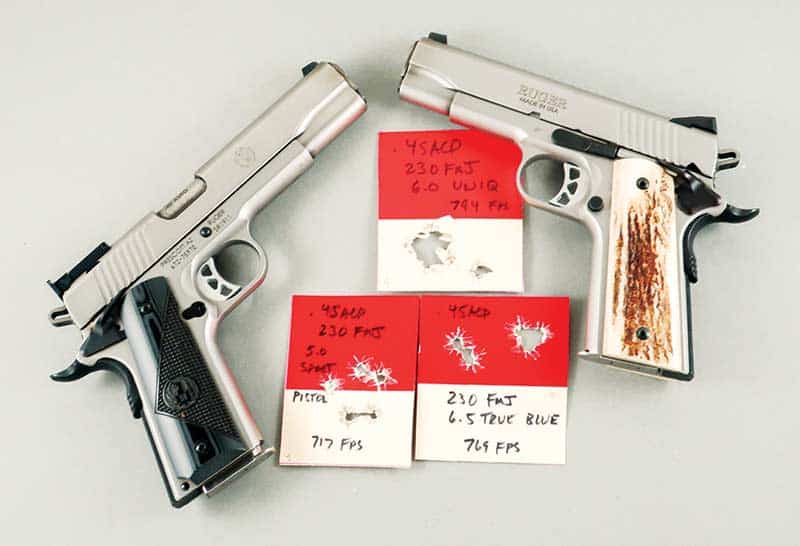Handloading the
.45 ACP: Part 3
Jacketed Bullets
In 1905 John Browning designed a semi-automatic pistol firing a new .45 cartridge the style of which we now label “rimless,” even though it does actually have a rim for the extractor. By 1911 the Browning design had become the 1911 Colt Government Model with one of the changes being a more user-friendly angle grip frame instead of the straight grip of the original. The cartridge would also be changed with the 200-grain bullet being replaced by a 230-grain round-nosed full metal jacket bullet at just over 800 fps. This cartridge soon became legendary for its stopping power and it’s a dead ringer in performance for the .45 Schofield cartridge the military had been using for over 30 years.
Hardball History
Now over 100 years later, not only is the 1911 Government Model still the semi-automatic by which all other pistols are judged, the original loading is still an excellent choice for everyday use — even though we have seen a long list of .45 ACP cartridges arrive with other bullets including flat-nosed and hollowpoint versions. I purchased my first 1911 Government Model in 1956 and shot it exclusively with military surplus 230-grain Hardball ammunition. This original “Colt” was actually a Remington Rand-produced 1911 for use in WWII. When I moved my young family across the country in 1966, the 1911 loaded with Hardball was in its military holster under the front seat of our 1965 Ford Station Wagon. When I traveled back and forth to the University of Montana for three summers working on my Masters Degree, the same 1911 — again loaded with hardball — rode behind my back in my belt. During those summers when I needed a break from class during the week, I would drive up to Lolo Pass and shoot the 1911. It seemed to help lower my frustrations.
I load and shoot a large amount of cast bullets in my 1911s, however jacketed bullets are not ignored and are also used in large quantities. As outlined in the first installment of this series, all of my .45 ACP rounds — and I do mean all — no matter what bullets I am using, are loaded the same way. First all brass is sized using the Lee Undersized Carbide Sizing Die, then case mouths are expanded just enough to accept the bullet using the Lee Universal Expanding Die. After placing the proper powder charge and seating the bullet without crimping, I then turn to the Lee Factory Crimp Die. All of this ensures reloads will function in any 1911 I happen to use.
To duplicate the original Hardball load I have found a 230-grain FMJ bullet over 6.0 grains of Unique gives me 825 fps from a standard 5″ barrel while 5.0 grains of Red Dot is about 25 fps faster. The latter load is especially accurate, giving groups just over 1″ at 20 yards through a Springfield Armory TRP 1911. A slightly lighter load using the same 230-grain bullet is 5.0 grains of Bullseye for just over 800 fps with five shots in less than 1″ through this same Springfield TRP. For a target load with this bullet, 3.5 grains of Bulleye is a very mild shooting 625 fps and an equally accurate load through this Springfield. Switching to 5.0 grains of Alliant Sport Pistol powder gives me a very mild shooting load just over 750 fps which has proven to be exceptionally accurate in an Iver Johnson Long Slide 6″ 1911.
Jackets Required
There are many hollowpoint jacketed bullets available and I have found both the Hornady and Sierra 185-grain versions to be quite accurate. In fact, so accurate it is hard to find a load that is not exceptional. Using the Colt 1911 Government Rail Model Stainless Steel, the Hornady 185 JHP over 8.5 grains of True Blue results in 1,025 fps and five shots in ¾” and 8.0 grains of CFE Pistol gives 980 fps and 1″ accuracy, while the same load with the Sierra JHP is right at 1,000 fps and a group of 7/8″ through the Colt 1911 Combat Elite.
As we saw in the installment covering cast bullets, one of my favorite bullets is the H&G #68 semi-wadcutter bullet, also duplicated by RCBS #45-201, and the Oregon Trail 45-200 SWC. A jacketed bullet for these is duplicated by a Hornady 200-grain jacketed semi-wadcutter. I load these with just a very slight protrusion of the bullet shoulder above the case mouth. Call it just over a hair’s length or just so I can barely see it. This seems to work very well for me in all 1911 pistols. This Full Metal Jacketed bullet over 7.0 grains of CFE Pistol powder through the above-mentioned Colt Rail Model clocks out at 885 fps with a group under 1″ while 8.0 grains of Powder Pistol is 90 fps faster and a group just over 1″ for five shots. In addition to the typical 230-grain Hardball bullet Hornady also offers a 230-grain flat-nosed version which I have found to also be exceptionally accurate. With 7.0 grains of True Blue, the velocity through the Colt Rail Model is 845 fps with a 1″ group while 7.0 grains of CFE Pistol powder results in a load which is 40 fps faster and just under one inch.
With a choice of so many excellent FMJ and JHP bullets what is the best choice for everyday carry, especially when traveling off the beaten path? My friend, custom gunsmith Gary Reeder, found himself in a situation where he had to put down a black bear which had been hit by a vehicle and, though incapacitated, was still very much alive. Gary found a hollowpoint would not get the job done, however a hardball bullet penetrated to the vitals. I prefer to stagger rounds in the .45 ACP magazine between FMJ and JHP loads so hopefully I am prepared for any situation.








